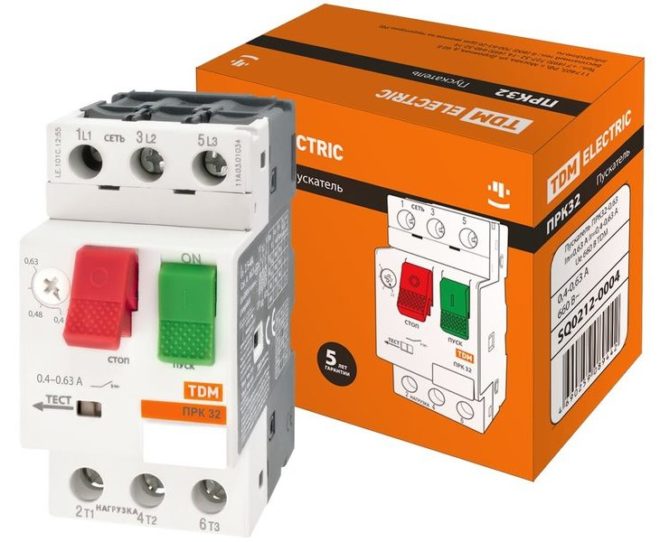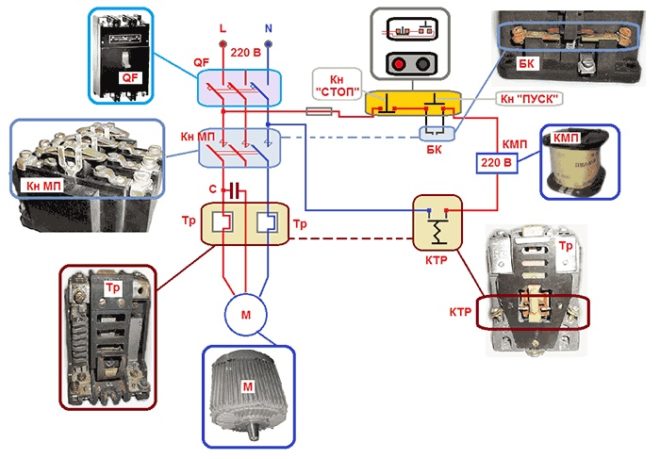Circuit breaker for motor protection - how to choose the right one?

When selecting circuit breakers capable of protecting electric motors from damage as a result of short-circuit or excessively high loads, it is necessary to take into account a large amount of starting current, often 5-7 times higher than the nominal. Asynchronous power units with a squirrel-cage rotor are subject to the most powerful starting overloads. Since this equipment is widely used for work in industrial and domestic conditions, the issue of protecting both the device itself and the power cable is very relevant. This article will discuss how to correctly calculate and choose an electric motor protection circuit breaker.
Content
Tasks of devices for protecting electric motors
Household electrical appliances from large inrush currents in networks are usually protected by three-phase circuit breakers that are triggered some time after the current exceeds the rated value. Thus, the motor shaft has time to spin up to the required rotation speed, after which the force of the electron flow decreases. But protective devices used in everyday life are not fine-tuned. Therefore, the choice of a circuit breaker that allows you to protect an induction motor from overloads and short-circuit overcurrents is more difficult.

Modern circuit breakers for motor protection are often installed in a common housing with starters (the so-called switching devices for starting the motor). They are designed to perform the following tasks:
- Protection of the device against overcurrent generated inside the motor or in the power supply circuit.
- Protection of the power unit from phase conductor breakage, as well as phase imbalance.
- Providing a time delay, which is necessary so that the motor, forced to stop as a result of overheating, has time to cool down.
Control and protective automatics for the engine in the video:
- Shutdown of the installation if the load is no longer supplied to the shaft.
- Protection of the power unit from long overloads.
- Protection of the electric motor against overheating (to perform this function, additional temperature sensors are mounted inside the unit or on its body).
- Indication of operating modes, as well as notification of emergency conditions.
It should also be borne in mind that the motor-protective circuit breaker must be compatible with monitoring and control mechanisms.
Calculation of an automatic machine for an electric motor
Until recently, the following scheme was used to protect electric motors: a thermal regulator was installed inside the starter, connected in series with a contactor. This mechanism worked like this. When a large current passed through the relay for a long time, the bimetallic plate installed in it was heated, which, bending, interrupted the contactor circuit. If the excess of the set load was short-term (as happens when starting the engine), the plate did not have time to heat up and trigger the machine.
The internal structure of the motor protection circuit breaker in the video:
The main disadvantage of such a scheme was that it did not save the unit from voltage surges, as well as phase imbalance. Now the protection of electrical power plants is provided by more accurate and modern devices, which we will talk about a little later.And now let's move on to the question of how the machine is calculated, which must be installed in the electric motor circuit.
To choose a protective circuit breaker for an electrical installation, you need to know its time-current characteristic, as well as the category. The time-current characteristic does not depend on the rated current for which the AB is designed.

To prevent the circuit breaker from tripping every time the motor is started, the starting current should not be greater than that which causes the device to instantly trip (cut-off). The ratio of the starting current and the rating is prescribed in the equipment passport, the maximum allowable is 7/1.
When calculating the machine in practice, you should use the safety factor, denoted by the symbol Kn.If the rated current of the device does not exceed 100A, then the value of Knis 1.4; for large values, it is 1.25. Based on this, the value of the cut-off current is determined by the formula Ifrom ≥ Kn x Istart... We select the circuit breaker in accordance with the calculated parameters.
Another value that must be taken into account when selecting, when the machine is mounted in an electrical panel or a special cabinet, is the temperature coefficient (TOt). This value is 0.85, and the rated current of the protective device when sizing should be multiplied by it (In/TOt).
Modern devices for electrical protection of power units
Modular motor-automatic machines are very popular, they are universal devices that successfully cope with all the functions described above.

In addition, they can be used to adjust the shutdown parameters with high accuracy.
Modern motor-automatic machines are presented in many varieties, differing from each other in appearance, characteristics and method of control. As with the selection of a conventional device, you need to know the value of the starting, as well as the rated current. In addition, it is necessary to decide what functions the protective device should perform. Having made the necessary calculations, you can buy an automatic motor. The price of these devices directly depends on their capabilities and the power of the electric motor.
Features of protection of electric motors in industrial conditions
Often, when devices with a power exceeding 100 kW are turned on, the voltage in the general network drops below the minimum. In this case, the shutdown of the working power units does not occur, but the number of their revolutions decreases. When the voltage returns to normal levels, the motor starts to revive. Moreover, its work takes place in the overload mode. This is called self-starting.
Self-starting sometimes causes AB to falsely operate. This can happen when the installation has been operating in normal mode for a long time before the temporary voltage drop, and the bimetallic plate has had time to warm up. In this case, the thermal release sometimes trips before the voltage is normalized. An example of a voltage drop in a car's electrical network in the following video:
To prevent the shutdown of powerful factory electric motors during self-starting, relay protection is used, in which current transformers are included in the common network. Protective relays are connected to their secondary windings. These systems are selected using complex calculations. We will not give them here, since in production this task is performed by regular power engineers.
Conclusion
In this article, we covered in detail the topic of protective devices for electric motors, and figured out how to choose an automatic machine for an electric motor and what parameters should be taken into account. Our readers could be convinced that the calculations that are made in this case are not at all difficult, which means that it is quite possible to choose a device for a network into which a not too powerful power unit is included.






